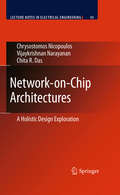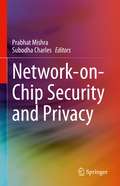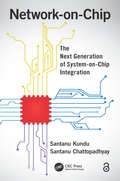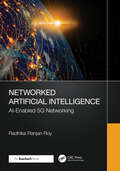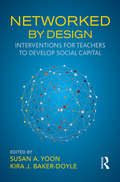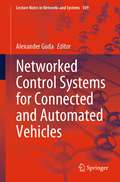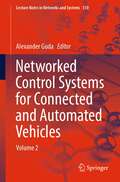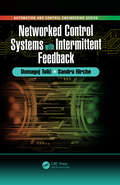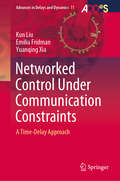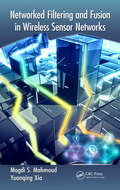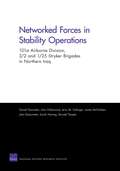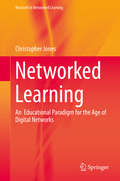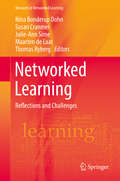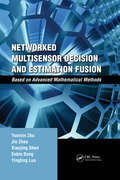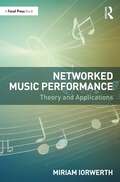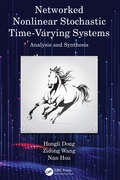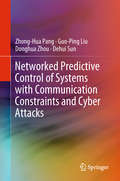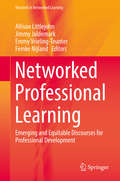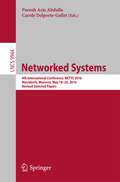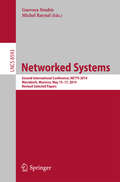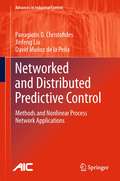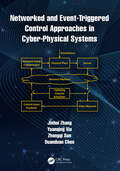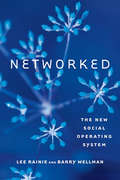- Table View
- List View
Network-on-Chip Architectures
by Chita R. Das Vijaykrishnan Narayanan Chrysostomos NicopoulosThe continuing reduction of feature sizes into the nanoscale regime has led to dramatic increases in transistor densities. Integration at these levels has highlighted the criticality of the on-chip interconnects. Network-on-Chip (NoC) architectures are viewed as a possible solution to burgeoning global wiring delays in many-core chips, and have recently crystallized into a significant research domain. On-chip networks instill a new flavor to communication research due to their inherently resource-constrained nature. Despite the lightweight character demanded of the NoC components, modern designs require ultra-low communication latencies in order to cope with inflating data bandwidths. The work presented in Network-on-Chip Architectures addresses these issues through a comprehensive exploration of the design space. The design aspects of the NoC are viewed through a penta-faceted prism encompassing five major issues: (1) performance, (2) silicon area consumption, (3) power/energy efficiency, (4) reliability, and (5) variability. These five aspects serve as the fundamental design drivers and critical evaluation metrics in the quest for efficient NoC implementations. The research exploration employs a two-pronged approach: (a) MICRO-architectural innovations within the major NoC components, and (b) MACRO-architectural choices aiming to seamlessly merge the interconnection backbone with the remaining system modules. These two research threads and the aforementioned five key metrics mount a holistic and in-depth attack on most issues surrounding the design of NoCs in multi-core architectures.
Network-on-Chip Security and Privacy
by Prabhat Mishra Subodha CharlesThis book provides comprehensive coverage of Network-on-Chip (NoC) security vulnerabilities and state-of-the-art countermeasures, with contributions from System-on-Chip (SoC) designers, academic researchers and hardware security experts. Readers will gain a clear understanding of the existing security solutions for on-chip communication architectures and how they can be utilized effectively to design secure and trustworthy systems.
Network-on-Chip: The Next Generation of System-on-Chip Integration
by Santanu Kundu Santanu ChattopadhyayAddresses the Challenges Associated with System-on-Chip Integration Network-on-Chip: The Next Generation of System-on-Chip Integration examines the current issues restricting chip-on-chip communication efficiency, and explores Network-on-chip (NoC), a promising alternative that equips designers with the capability to produce a scalable, reusable, and high-performance communication backbone by allowing for the integration of a large number of cores on a single system-on-chip (SoC). This book provides a basic overview of topics associated with NoC-based design: communication infrastructure design, communication methodology, evaluation framework, and mapping of applications onto NoC. It details the design and evaluation of different proposed NoC structures, low-power techniques, signal integrity and reliability issues, application mapping, testing, and future trends. Utilizing examples of chips that have been implemented in industry and academia, this text presents the full architectural design of components verified through implementation in industrial CAD tools. It describes NoC research and developments, incorporates theoretical proofs strengthening the analysis procedures, and includes algorithms used in NoC design and synthesis. In addition, it considers other upcoming NoC issues, such as low-power NoC design, signal integrity issues, NoC testing, reconfiguration, synthesis, and 3-D NoC design. This text comprises 12 chapters and covers: The evolution of NoC from SoC—its research and developmental challenges NoC protocols, elaborating flow control, available network topologies, routing mechanisms, fault tolerance, quality-of-service support, and the design of network interfaces The router design strategies followed in NoCs The evaluation mechanism of NoC architectures The application mapping strategies followed in NoCs Low-power design techniques specifically followed in NoCs The signal integrity and reliability issues of NoC The details of NoC testing strategies reported so far The problem of synthesizing application-specific NoCs Reconfigurable NoC design issues Direction of future research and development in the field of NoC Network-on-Chip: The Next Generation of System-on-Chip Integration covers the basic topics, technology, and future trends relevant to NoC-based design, and can be used by engineers, students, and researchers and other industry professionals interested in computer architecture, embedded systems, and parallel/distributed systems.
Networked Artificial Intelligence: AI-Enabled 5G Networking
by Radhika Ranjan RoyThe integration of fifth generation (5G) wireless technologies with distributed artificial intelligence (AI) is transforming network operations. AI is increasingly embedded in all network elements, from cloud and edge to terminal devices, enabling AI to function as a networking system. This convergence facilitates AI-based applications across the global network, with notable successes in various domains such as computer vision, natural language processing, and healthcare. Networked Artificial Intelligence: AI-Enabled 5G Networking a comprehensive framework for the deep integration of computing and communications, optimizing networks and applications as a unified system using AI.The book covers topics ranging from networked AI fundamentals to AI-enabled 5G networks, including agent modeling, machine learning (ML) algorithms, and network protocol architectures. It discusses how network service providers can leverage AI and ML techniques to customize network baselines, reduce noise, and accurately identify issues. It also looks at AI-driven networks that enable self-correction for maximum uptime and prescriptive actions for issue resolution, as well as troubleshooting by capturing and storing data before network events.The book presents a comprehensive approach to AI-enabled networking that offers unprecedented opportunities for efficiency, reliability, and innovation in telecommunications. It works through the approach’s five steps of connection, communication, collaboration, curation, and community. These steps enhance network effects, empowering operators with insights for trusted automation, cost reduction, and optimal user experiences. The book also discusses AI and ML capabilities that enable networks to continuously learn, self-optimize, and predict and rectify service degradations proactively, even with full automation.
Networked By Design: Interventions for Teachers to Develop Social Capital
by Susan A. Yoon Kira J. Baker-DoyleNetworked by Design brings together work from leading international scholars in the learning sciences that applies social network theory to teachers’ social interactions and relationships. The volume examines the direct and indirect relationships and communities that teachers navigate, as well as the models, plans, and other interventions that allow them to exercise control over these networks. Each chapter draws from case studies or latitudinal research to investigate a different intervention and its outcomes. By presenting research conducted in a variety of scales and contexts, this book offers scholars, future teachers, and leaders diverse insights into how interventions in social capital and social networks can create impactful, meaningful teaching and learning.
Networked Control Systems for Connected and Automated Vehicles: Volume 1 (Lecture Notes in Networks and Systems #509)
by Alexander GudaThis book is a collection of the latest research findings in such areas as networked multi-agent systems, co-design of communication and control, distributed control strategies that can cope with asynchrony between local loops, event-triggered control, modelling of network infrastructure, novel concepts of distributed control for networked and cyber-physical systems. The book contains the result of the latest research in the field of communication and control system design to support networked control systems with stringent real-time requirements. It introduces readers to research in the field of joint design of the control and communication protocol and presents the latest developments in the area of novel optimal control and scheduling designs under resource constraints.The book also covers the issues of creating emerging information and communication technologies for traffic estimation and control, connected and autonomous technology applications and modelling for commercial and shared vehicle operations. The reader will find information on emerging cyber-physical systems, networked multi-agent systems, large-scale distributed energy systems, as well as on real-time systems, safety and security systems.A significant block of studies is devoted to the topic of transitions towards electrification and automation of vehicles. Modern concepts of road infrastructure construction are described in detail in the presented research papers.Automotive industry professionals will be particularly interested in the sections on the novel mechanisms for medium access in multi-hop wireless networks with real-time requirements, optimal layering architecture and co-design for wireless communication. The book will be incredibly interesting for researchers interested in human–digital interfaces, industrial Internet of Things, artificial intelligence and machine learning.
Networked Control Systems for Connected and Automated Vehicles: Volume 2 (Lecture Notes in Networks and Systems #510)
by Alexander GudaControl of large-scale distributed energy systems over communication networks is an important topic with many application domains. The book presents novel concepts of distributed control for networked and cyber-physical systems (CPS), such as smart industrial production lines, smart energy grids, and autonomous vehicular systems. It focuses on new solutions in managing data and connectivity to support connected and automated vehicles (CAV).The book compiles original research papers presented at the conference “Networked Control Systems for Connected and Automated Vehicles” (Russia). The latest connected and automated vehicle technologies for next generation autonomous vehicles are presented. The book sets new goals for the standardization of the scientific results obtained and the advancement to the level of full autonomy and full self-driving (FSD). The book presents the latest research in artificial intelligence, assessing virtual environments, deep learning systems, and sensor fusion for automated vehicles. Particular attention is paid to new safety standards, safety and security systems, and control of epidemic spreading over networks. The issues of building modern transport infrastructure facilities are also discussed in the articles presented in this book.The book is of considerable interest to scientists, researchers, and graduate students in the field of transport systems, as well as for managers and employees of companies using or producing equipment for these systems.
Networked Control Systems with Intermittent Feedback (Automation and Control Engineering)
by Domagoj Tolić Sandra HircheNetworked Control Systems (NCSs) are spatially distributed systems for which the communication between sensors, actuators and controllers is realized by a shared (wired or wireless) communication network. NCSs offer several advantages, such as reduced installation and maintenance costs, as well as greater flexibility, over conventional control systems in which parts of control loops exchange information via dedicated point-to-point connections. The principal goal of this book is to present a coherent and versatile framework applicable to various settings investigated by the authors over the last several years. This framework is applicable to nonlinear time-varying dynamic plants and controllers with delayed dynamics; a large class of static, dynamic, probabilistic and priority-oriented scheduling protocols; delayed, noisy, lossy and intermittent information exchange; decentralized control problems of heterogeneous agents with time-varying directed (not necessarily balanced) communication topologies; state- and output-feedback; off-line and on-line intermittent feedback; optimal intermittent feedback through Approximate Dynamic Programming (ADP) and Reinforcement Learning (RL); and control systems with exogenous disturbances and modeling uncertainties.
Networked Control Under Communication Constraints: A Time-Delay Approach (Advances in Delays and Dynamics #11)
by Yuanqing Xia Emilia Fridman Kun LiuThis book presents a time-delay approach to the analysis and synthesis of networked control systems (NCSs) under communication constraints. Differently from other approaches, the time-delay approach to NCSs allows communication delays to be larger than the sampling intervals in the presence of scheduling protocols. The book starts from a comprehensive introduction to three main approaches to sampled-data and networked control. It then focuses on time-delay approach, and the modelling of the closed-loop systems in the form of time-delay system. It presents discontinuous (in time) Lyapunov functional constructions that are efficient for NCSs in the presence of communications delays. Further, it highlights time-delay approaches developed to model and analyze NCSs under communication constraints, with a particular focus on dynamic quantization, round-robin, try-once-discard and stochastic protocols. The results are first presented for the continuous-time NCSs and then extended to discrete-time NCSs. Discussing recent developments in Lyapunov-based analysis of NCSs under communication constraints, the book is a valuable resource for researchers interested in sampled-data and networked control, and time-delay systems, as well as for graduate students in automatic control and systems theory.
Networked Filtering and Fusion in Wireless Sensor Networks
by Magdi S. Mahmoud Yuanqing XiaBy exploiting the synergies among available data, information fusion can reduce data traffic, filter noisy measurements, and make predictions and inferences about a monitored entity. Networked Filtering and Fusion in Wireless Sensor Networks introduces the subject of multi-sensor fusion as the method of choice for implementing distributed systems.T
Networked Forces in Stability Operations: 101st Airborne Division, 3/2 and 1/25 Stryker Brigades in Northern Iraq
by Jerry M. Sollinger John Hollywood Daniel Gonzales James Mcfadden John DejarnetteCompares three units that conducted stability operations in the same area in northern Iraq-the 101st Airborne Division (which had only limited digital communications), the 3/2 Stryker brigade combat team (SBCT), and the 1/25 SBCT (both equipped with digital networks) and finds that leadership, training, and tactics and procedures are just as important as networking capabilities for improving mission effectiveness in stability operations.
Networked Learning
by Christopher JonesThis book posits the idea that networked learning is the one new paradigm in learning theory that has resulted from the introduction of digital and networked technologies It sets out, in a single volume, a critical review of the main ideas and then articulates the case for adopting a networked learning perspective in a variety of educational settings. This book fills a gap in the literature on networked learning Although there are several edited volumes in the field there is no other monograph makes the academic case and provides the academic context for networked learning. This volume accomplishes three main goals. First, it assists researchers and practitioners in acquainting themselves with the field. Second, it provides resources for reference and guidance to those not well acquainted with the field Finally and most powerfully, it also allows for the consolidation of a field that is truly multidisciplinary in a way that maintains coherence and consistency.
Networked Learning: Reflections And Challenges (Research in Networked Learning)
by Thomas Ryberg Maarten De Laat Nina Bonderup Dohn Susan Cranmer Julie-Ann SimeThe book is based on nine selected, peer-reviewed papers presented at the 10th biennial Networked Learning Conference (NLC) 2016 held in Lancaster. Informed by suggestions from delegates, the nine papers have been chosen by the editors (who were the Chairs of the Conference) as exemplars of cutting edge research on networked learning. Further reviews of all papers were conducted once they were revised as chapters for the book. The chapters are organized into two sections: 1) Situating Networked Learning: Looking Back - Moving Forward, 2) New Challenges: Designs for Networked Learning in the Public Arena. Further, we include an introduction which looks at the evolution of trends in Networked Learning through a semantic analysis of conference papers from the 10 conferences. A final chapter draws out perspectives from the chapters and discusses emerging issues. The book is the fifth in the Networked Learning Conference Series.
Networked Machinists: High-Technology Industries in Antebellum America (Johns Hopkins Studies in the History of Technology)
by David R. MeyerA century and a half before the modern information technology revolution, machinists in the eastern United States created the nation's first high technology industries. In iron foundries and steam-engine works, locomotive works, machine and tool shops, textile-machinery firms, and firearms manufacturers, these resourceful workers pioneered the practice of dispersing technological expertise through communities of practice. In the first book to study this phenomenon since the 1916 classic, English and American Tool Builders, David R. Meyer examines the development of skilled-labor exchange systems, showing how individual metalworking sectors grew and moved outward. He argues that the networked behavior of machinists within and across industries helps explain the rapid transformation of metalworking industries during the antebellum period, building a foundation for the sophisticated, mass production/consumer industries that figured so prominently in the later U.S. economy.
Networked Multisensor Decision and Estimation Fusion: Based on Advanced Mathematical Methods
by Jie Zhou Yunmin Zhu Xiaojing Shen Enbin Song Yingting LuoDue to the increased capability, reliability, robustness, and survivability of systems with multiple distributed sensors, multi-source information fusion has become a crucial technique in a growing number of areas-including sensor networks, space technology, air traffic control, military engineering, agriculture and environmental engineering, and i
Networked Music Performance: Theory and Applications
by Miriam IorwerthNetworked Music Performance (NMP) is the essential guide to both playing music online and ensemble music through networks. Offering a range of case studies, from highly technical solutions to inclusive community projects, this book provides inspiration to musicians to try NMP whatever their level of technical expertise. Drawing upon recent research to examine the background and history of the practice as well as specific practical approaches, technical and musical considerations are included for readers, as are ideas around accessibility and creativity. Accessibility is considered in the context of the opportunities that NMP gives to musicians working remotely, as well as some of the barriers to participation in NMP and how these can be overcome. Synchronous and asynchronous approaches to NMP are explored in detail, examining the technical and musical affordances and challenges of working remotely for musicians. Networked Music Performance will appeal to music and music technology students as well as professional musicians and technicians who have started working online and wish to improve their practice. As NMP in the context of music education and community music are also explored, this book supplies educators and community leaders with knowledge and practical guidance on how to move their practice online.
Networked Non-linear Stochastic Time-Varying Systems: Analysis and Synthesis
by Zidong Wang Hongli Dong Nan HouNetworked Non-linear Stochastic Time-Varying Systems: Analysis and Synthesis copes with the filter design, fault estimation and reliable control problems for different classes of nonlinear stochastic time-varying systems with network-enhanced complexities. Divided into three parts, the book discusses the finite-horizon filtering, fault estimation and reliable control, and randomly occurring nonlinearities/uncertainties followed by designing of distributed state and fault estimators, and distributed filters. The third part includes problems of variance-constrained H∞ state estimation, partial-nodes-based state estimation and recursive filtering for nonlinear time-varying complex networks with randomly varying topologies, and random coupling strengths. Offers a comprehensive treatment of the topics related to Networked Nonlinear Stochastic Time-Varying Systems with rigorous math foundation and derivation Unifies existing and emerging concepts concerning control/filtering/estimation and distributed filtering Provides a series of latest results by drawing on the conventional theories of systems science, control engineering and signal processing Deal with practical engineering problems such as event triggered H∞ filtering, non-fragile distributed estimation, recursive filtering, set-membership filtering Demonstrates illustrative examples in each chapter to verify the correctness of the proposed results This book is aimed at engineers, mathematicians, scientists, and upper-level students in the fields of control engineering, signal processing, networked control systems, robotics, data analysis, and automation.
Networked Predictive Control of Systems with Communication Constraints and Cyber Attacks
by Guo-Ping Liu Zhong-Hua Pang Donghua Zhou Dehui SunThis book presents the latest results on predictive control of networked systems, where communication constraints (e.g., network-induced delays and packet dropouts) and cyber attacks (e.g., deception attacks and denial-of-service attacks) are considered. For the former, it proposes several networked predictive control (NPC) methods based on input-output models and state-space models respectively. For the latter, it designs secure NPC schemes from the perspectives of information security and real-time control. Furthermore, it uses practical experiments to demonstrate the effectiveness and applicability of all the methods, bridging the gap between control theory and practical applications. The book is of interest to academic researchers, R&D engineers, and graduate students in control engineering, networked control systems and cyber-physical systems.
Networked Professional Learning: Emerging and Equitable Discourses for Professional Development (Research in Networked Learning)
by Allison Littlejohn Jimmy Jaldemark Emmy Vrieling-Teunter Femke NijlandOver the past decades a new form of professionalism has emerged, characterized by factors of fluidity, instability and continual change, leading to the necessitation of new forms of professional development that support agile and flexible expansion of professional practice. At the same time, the digitization of work has had a profound effect on professional practice. This digitization opens up opportunities for new forms of professional learning mediated by technologies through networked learning. Networked learning is believed to lead to a more efficient flow of complex knowledge and routine information within the organization, stimulate innovative behaviour, and result in a higher job satisfaction. In this respect, networked learning can be perceived as an important perspective on both professional and organizational development. This volume provides examples of Networked Professional Learning, it questions the impact of this emerging form of learning on the academy, and it interrogates the impact on teachers of the future. It features three sections that explore networked professional learning from different perspectives: questioning what legitimate forms of networked professional learning are across a broad sampling of professions, how new forms of professional learning impact institutions of higher education, and the value creation that Networked Learning offers professionals in broader educational, economic, and social contexts. The book is of interest to researchers in the area of professional and digital learning, higher education managers, organizational HR professionals, policy makers and students of technology enhanced learning.
Networked Refugees: Palestinian Reciprocity and Remittances in the Digital Age (Critical Refugee Studies #2)
by Nadya HajjA free open access ebook is available upon publication. Learn more at www.luminosoa.org. Almost 68.5 million refugees in the world today live in a protection gap, the chasm between protections stipulated in the Geneva Convention and the abrogation of those responsibilities by states and aid agencies. With dwindling humanitarian aid, how do refugee communities solve collective dilemmas, like raising funds for funeral services, or securing other critical goods and services? In Networked Refugees, Nadya Hajj finds that Palestinian refugees utilize Information Communication Technology platforms to motivate reciprocity—a cooperative action marked by the mutual exchange of favors and services—and informally seek aid and connection with their transnational diaspora community. Using surveys conducted with Palestinians throughout the diaspora, interviews with those inside the Nahr al Bared Refugee camp in Lebanon, and data pulled from online community spaces, these findings push back against the cynical idea that online organizing is fruitless, emphasizing instead the productivity of these digital networks.
Networked Systems
by Parosh Aziz Abdulla Carole Delporte-GalletThis book constitutes the refereed post-proceedings of the 4th International Conference on Networked Systems, NETYS 2016, held in Marrakech, Morocco, in May 2016. The 22 full papers and 11 short papers presented together with 19 poster abstracts were carefully reviewed and selected from 121 submissions. They report on best practices and novel algorithms, results and techniques on networked systems and cover topics such as multi-core architectures, concurrent and distributed algorithms, parallel/concurrent/distributed programming, distributed databases, cloud systems, networks, security, and formal verification.
Networked Systems
by Guevara Noubir Michel RaynalThis book constitutes the revised selected papers of the Second International Conference on Networked Systems, NETYS 2014, held in Marrakech, Morocco, in May 2014. The 20 full papers and the 6 short papers presented together with 2 keynotes were carefully reviewed and selected from 80 submissions. They address major topics such as multi-core architectures; concurrent and distributed algorithms; middleware environments; storage clusters; social networks; peer-to-peer networks; sensor networks; wireless and mobile networks; as well as privacy and security measures to protect such networked systems and data from attack and abuse.
Networked and Distributed Predictive Control
by David Muñoz de la Peña Jinfeng Liu Panagiotis D. ChristofidesNetworked and Distributed Predictive Control presents rigorous, yet practical, methods for the design of networked and distributed predictive control systems - the first book to do so. The design of model predictive control systems using Lyapunov-based techniques accounting for the influence of asynchronous and delayed measurements is followed by a treatment of networked control architecture development. This shows how networked control can augment dedicated control systems in a natural way and takes advantage of additional, potentially asynchronous and delayed measurements to maintain closed loop stability and significantly to improve closed-loop performance. The text then shifts focus to the design of distributed predictive control systems that cooperate efficiently in computing optimal manipulated input trajectories that achieve desired stability, performance and robustness specifications but spend a fraction of the time required by centralized control systems. Key features of this book include: * new techniques for networked and distributed control system design; * insight into issues associated with networked and distributed predictive control and their solution; * detailed appraisal of industrial relevance using computer simulation of nonlinear chemical process networks and wind- and solar-energy-generation systems; and * integrated exposition of novel research topics and rich resource of references to significant recent work. A full understanding of Networked and Distributed Predictive Control requires a basic knowledge of differential equations, linear and nonlinear control theory and optimization methods and the book is intended for academic researchers and graduate students studying control and for process control engineers. The constant attention to practical matters associated with implementation of the theory discussed will help each of these groups understand the application of the book's methods in greater depth.
Networked and Event-Triggered Control Approaches in Cyber-Physical Systems
by Yuanqing Xia Jinhui Zhang Zhongqi Sun Duanduan ChenThe insertion of communication networks in feedback control loops complicates analysis and synthesis of cyber-physical systems (CPSs), and network-induced uncertainties may degrade system control performance. Thus, this book researches networked delay compensation and event-triggered control approaches for a series of CPSs subject to network-induced uncertainties. The authors begin with an introduction to the concepts and challenges of CPSs, followed by an overview of networked control approaches and event-triggered control strategies in CPSs. Then, networked delay compensation and event-triggered control approaches are proposed for CPSs with network communication delay, data dropout, signal quantization, and event-triggered communication. More specifically, networked delay compensation approaches are proposed for linear/nonlinear networked controlled plants with time-varying and random network communication delays and data dropouts. To reduce computational burden and network communication loads in CPSs, event-triggered control, self-triggered control, co-design of event-triggered control and quantized control techniques, and event-triggered disturbance rejection control approaches are also presented. This book is an essential text for researchers and engineers interested in cybersecurity, networked control, and CPSs. It would also prove useful for graduate students in the fields of science, engineering, and computer science.
Networked: The New Social Operating System (Contemporary Studies In Sociology Ser. #Vol. 15)
by Lee Rainie Barry WellmanHow social networks, the personalized Internet, and always-on mobile connectivity are transforming—and expanding—social life.Daily life is connected life, its rhythms driven by endless email pings and responses, the chimes and beeps of continually arriving text messages, tweets and retweets, Facebook updates, pictures and videos to post and discuss. Our perpetual connectedness gives us endless opportunities to be part of the give-and-take of networking.Some worry that this new environment makes us isolated and lonely. But in Networked, Lee Rainie and Barry Wellman show how the large, loosely knit social circles of networked individuals expand opportunities for learning, problem solving, decision making, and personal interaction. The new social operating system of “networked individualism” liberates us from the restrictions of tightly knit groups; it also requires us to develop networking skills and strategies, work on maintaining ties, and balance multiple overlapping networks.Rainie and Wellman outline the “triple revolution” that has brought on this transformation: the rise of social networking, the capacity of the Internet to empower individuals, and the always-on connectivity of mobile devices. Drawing on extensive evidence, they examine how the move to networked individualism has expanded personal relationships beyond households and neighborhoods; transformed work into less hierarchical, more team-driven enterprises; encouraged individuals to create and share content; and changed the way people obtain information. Rainie and Wellman guide us through the challenges and opportunities of living in the evolving world of networked individuals.
